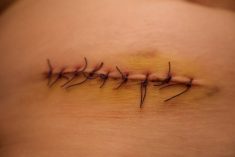All pain and discomfort can be linked back to our nerves, but nerve-related pain has some specific qualities.
Nerve pain can manifest as sharp, shooting sensations similar to electric shocks, or as a constant burning, tingling or pins-and-needles sensation. It may also present as aching, areas of heightened or lowered sensation, temperature differences or chronic tension.
This pain typically radiates along specific nerve pathways and can be triggered or worsened by certain movements, positions or pressure points. Nerves can become irritated due to inflammation, immune system activation, physical and emotional trauma and fatigue. Nerve-related pain will also increase in intensity in relation to emotional stress and anxiety.
Read Also

Gentle treatments for pain in the neck
Heading toward year-end, people unknowingly tense up against the cold and busyness, causing neck pain that can often be treated with appropriate support and gentle mobility, athletic therapist Kathlyn Hossack says.
Health care providers manage nerve pain through a comprehensive approach. Physical therapy is crucial, using specific exercises, stretches and manual therapy techniques to reduce nerve pressure and improve mobility. Equally important are lifestyle modifications, including adjustments to daily activities, posture and ergonomics to minimize nerve irritation, along with appropriate nutrition support.
Whenever someone is experiencing suspected nerve-related discomfort, I employ manual therapies first and foremost to support the nervous system through touch. Touch is a powerful mediator of sensation, and manual therapies can support improved circulation, relaxation and sensation change to irritated areas. When working with nerve-related pain, it’s important to both work with the painful area and track to where the nerve root originates, then support that area — often along the spine — as nerve pain can travel and will generally not resolve just by treating local areas.
Since stress can amplify nerve pain, stress management techniques such as breathing practices, meditation and gentle movement are often recommended. Temperature therapy — either heat or cold, depending on individual response — can help manage pain and reduce inflammation. Many people find relief through alternative therapies such as acupuncture or massage therapy. A key aspect of successful nerve pain management is finding the right balance between rest and activity, as both overexertion and prolonged inactivity can worsen symptoms.
I often recommend self-massage with oil (olive oil works well, or find a local maker of herbal-infused body oils). Nerves love oil-based lipids. Topically applying them can help you access the benefit of touch while nourishing the skin — and the nerves underneath — as a regular routine.
Nerve-related pain often takes longer than other soft tissue-related symptoms to resolve. A good rule of thumb is to expect nerve-related pain to take anywhere from a few months to a few years to completely and consistently resolve. It’s important to know there are solutions and reliefs to support nerve pain and any root causes generating it. It should not be ignored and generally will respond well to the right form of therapy, guidance and medication if necessary.
If you’re experiencing pain that doesn’t respond to conservative treatment methods, please consult a rehabilitation-focused professional or your medical practitioner for further investigation.















